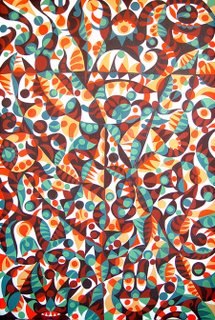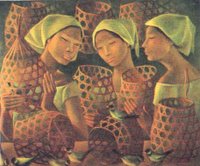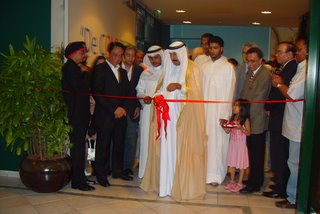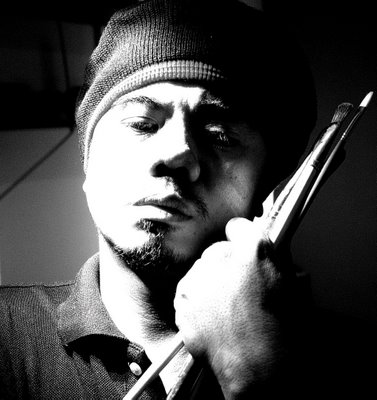
"Untitled" Oil on Canvas, 3.5m X 1.85m, A new movement to be exhibited at the Doust Gallery, Al Fanar Mall, Kuwait in December. Also will be a part of a show in Makati, Philippines sometime early 2007.





 Seven minutes is Federico Aguilar Alcuaz's record for finishing a landscape or portrait. That seven minutes, though, according to the writer Anthony John R. Balisi, "means seven minutes and a lifetime of practice." Born in Manila in 1932, Alcuaz studied law at the Ateneo de Manila and fine arts at the University of the Philippines. He then went to Madrid on a one-year scholarship to the Real Academia de Bellas de San Fernando, the same school attended by Juan Luna, Felix Resurrecion Hidalgo, Fabian de la Rosa and Fernando Amorsolo. But he only stayed for two weeks: his professors could not teach him anything new. He was "way ahead of his peers." From Madrid he went to Barcelona and pursued painting, coming home eight years later after meeting a vehicular accident. Alcuaz made a name for himself not only in Manila, but also in Europe, and exhibited in Singapore and Chicago as well. His art "reflects his experience of foreign culture" even in his Tres Marias series or landscapes showing the Pasig River.
Seven minutes is Federico Aguilar Alcuaz's record for finishing a landscape or portrait. That seven minutes, though, according to the writer Anthony John R. Balisi, "means seven minutes and a lifetime of practice." Born in Manila in 1932, Alcuaz studied law at the Ateneo de Manila and fine arts at the University of the Philippines. He then went to Madrid on a one-year scholarship to the Real Academia de Bellas de San Fernando, the same school attended by Juan Luna, Felix Resurrecion Hidalgo, Fabian de la Rosa and Fernando Amorsolo. But he only stayed for two weeks: his professors could not teach him anything new. He was "way ahead of his peers." From Madrid he went to Barcelona and pursued painting, coming home eight years later after meeting a vehicular accident. Alcuaz made a name for himself not only in Manila, but also in Europe, and exhibited in Singapore and Chicago as well. His art "reflects his experience of foreign culture" even in his Tres Marias series or landscapes showing the Pasig River.  Named national Artist for the Visual Arts, Ang Kiukok no doubt belongs to this list. Known for his expressionist paintings of the crucified Christ and tortured and pained people and animals, Kiukok started by drawing the Lone Ranger and still lifes of goldfishes. Born in 1931, Kiukok honed his artistic talent by studying under the masters Victorio Edades, Diosdado Lorenzo, and Vicente Manansala at the University of Santo Tomas, assisting Manansala in doing the mural of the 14 stations of the Cross for the Church of the Holy Sacrifice at UP. After a while he received a study and travel grant with Manansala to Los Angeles, and from there visited the museums in New York and Paris. "His art was never the same again," wrote Melanie Uy.
Named national Artist for the Visual Arts, Ang Kiukok no doubt belongs to this list. Known for his expressionist paintings of the crucified Christ and tortured and pained people and animals, Kiukok started by drawing the Lone Ranger and still lifes of goldfishes. Born in 1931, Kiukok honed his artistic talent by studying under the masters Victorio Edades, Diosdado Lorenzo, and Vicente Manansala at the University of Santo Tomas, assisting Manansala in doing the mural of the 14 stations of the Cross for the Church of the Holy Sacrifice at UP. After a while he received a study and travel grant with Manansala to Los Angeles, and from there visited the museums in New York and Paris. "His art was never the same again," wrote Melanie Uy. 
 At 27 he moved to London and there "began to explore new themes and modes of expression as an artist in exile," wrote Delfin L. Tolentino, Jr. Bencab based his works on old photographs, "to serve as commentaries on the influence of Spanish and American colonization." When he exhibited in Manila in 1972, his acrylic works were "heralded as harbingers of change in contemporary Philippine art."
At 27 he moved to London and there "began to explore new themes and modes of expression as an artist in exile," wrote Delfin L. Tolentino, Jr. Bencab based his works on old photographs, "to serve as commentaries on the influence of Spanish and American colonization." When he exhibited in Manila in 1972, his acrylic works were "heralded as harbingers of change in contemporary Philippine art." As a young boy, Prudencio Lamarroza spent many days fishing and gathering mussels in the Chico and Am-burayan rivers in the Ilocos region. Years later, he did his Amburayan series based on those childhood memories. The Amburayan Queen, the river goddess, became a constant figure in his paintings. The environment was also a major theme recurring in his works. "He was among the earliest visual artists to comment on the environment and the imbalance in nature," wrote Anthony John R. Balisi. Lamorroza studied fine arts at the UST and the Philippine Women's University.It took awhile for Lao Lianben to try abstraction, but when he saw the work of MuChi, a Chinese painter and monk, he "became convinced of the many possibilities of the abstract mode." From then on,
As a young boy, Prudencio Lamarroza spent many days fishing and gathering mussels in the Chico and Am-burayan rivers in the Ilocos region. Years later, he did his Amburayan series based on those childhood memories. The Amburayan Queen, the river goddess, became a constant figure in his paintings. The environment was also a major theme recurring in his works. "He was among the earliest visual artists to comment on the environment and the imbalance in nature," wrote Anthony John R. Balisi. Lamorroza studied fine arts at the UST and the Philippine Women's University.It took awhile for Lao Lianben to try abstraction, but when he saw the work of MuChi, a Chinese painter and monk, he "became convinced of the many possibilities of the abstract mode." From then on,  Lao made minimalist meditative works using a limited palette of black, white and gray, which creates "spareness in his statements," according to the late art critic Leo Benesa. "Color for Lao merely disturbs the visual experience and is therefore disposable," wrote Maria Victoria T. Herrera. Lao studied fine arts at the University of the East and taught there for five years.
Lao made minimalist meditative works using a limited palette of black, white and gray, which creates "spareness in his statements," according to the late art critic Leo Benesa. "Color for Lao merely disturbs the visual experience and is therefore disposable," wrote Maria Victoria T. Herrera. Lao studied fine arts at the University of the East and taught there for five years. Arturo Luz had his first painting lessons from Pablo Amorsolo. When his father was assigned to a diplomatic post in the US, Luz took the opportunity to study further in the arts, first at the California College of Arts and Crafts on a scholarship, then at Brooklyn Museum Art School and at the Academic de la Grande Chaumier in Paris. Luz started out doing figurative works but settled on abstraction. He became known for his series of street musicians, vendors, cyclists and carnival performers, as well as for his linear paintings. Luz also did sculpture using wood, concrete and metal. He was named National Artist for the Visual Arts in 1997.
Arturo Luz had his first painting lessons from Pablo Amorsolo. When his father was assigned to a diplomatic post in the US, Luz took the opportunity to study further in the arts, first at the California College of Arts and Crafts on a scholarship, then at Brooklyn Museum Art School and at the Academic de la Grande Chaumier in Paris. Luz started out doing figurative works but settled on abstraction. He became known for his series of street musicians, vendors, cyclists and carnival performers, as well as for his linear paintings. Luz also did sculpture using wood, concrete and metal. He was named National Artist for the Visual Arts in 1997. Anita Magsaysay-Ho is the list's link to the "13 Moderns," a shortlist of artists drawn up by the National Artist Victorio Edades before World War II. Born in Manila, she studied art at the UP, the Art Students' League and the Cranbrook Academy of Art in Michigan. Called "the female Amorsolo," Magsaysay-Ho painted genre and women subjects. Her works have won international recognition, fetching high prices in auctions and usually done in her preferred medium, egg tempera.
Anita Magsaysay-Ho is the list's link to the "13 Moderns," a shortlist of artists drawn up by the National Artist Victorio Edades before World War II. Born in Manila, she studied art at the UP, the Art Students' League and the Cranbrook Academy of Art in Michigan. Called "the female Amorsolo," Magsaysay-Ho painted genre and women subjects. Her works have won international recognition, fetching high prices in auctions and usually done in her preferred medium, egg tempera.
 Junvenal Sanso was born in Catluna, Spain, grew up in the Philippines and now shuttles between Paris and Manila. He studied at the UP and regards Fernando Amorsolo as the artist-teacher who inspired him the most. He went for further studies in Europe. Labrador writes, "He remains fascinated with rustic scenes in the Philippines, such as native houses and fishing traps he has seen while growing up. Sanso's choice and method of color are the only indication that he has been living in Europe for some time." Prolific even at 72, he "doesn't see himself retiring, because a lot remains to be done."
Junvenal Sanso was born in Catluna, Spain, grew up in the Philippines and now shuttles between Paris and Manila. He studied at the UP and regards Fernando Amorsolo as the artist-teacher who inspired him the most. He went for further studies in Europe. Labrador writes, "He remains fascinated with rustic scenes in the Philippines, such as native houses and fishing traps he has seen while growing up. Sanso's choice and method of color are the only indication that he has been living in Europe for some time." Prolific even at 72, he "doesn't see himself retiring, because a lot remains to be done." The Artist with the "Dancing Gecko I" sold to Mr. Joe Kawasaki of Rainmakers Motion Pictures.
The Artist with the "Dancing Gecko I" sold to Mr. Joe Kawasaki of Rainmakers Motion Pictures.
 The Awardees
The Awardees Benedicto "BenCab" Cabrera
Benedicto "BenCab" Cabrera
 Me and my wife, Cecille.
Me and my wife, Cecille. My little angel, Aliyah who's also a part of the audience:-)
My little angel, Aliyah who's also a part of the audience:-) A pose with my Family.
A pose with my Family.
 The Ribbon-Cutting ceremony with Shiekh Bader Al Sabah and His Excellency Ambassador Ricardo Endaya.
The Ribbon-Cutting ceremony with Shiekh Bader Al Sabah and His Excellency Ambassador Ricardo Endaya. French Ambassador Corinne Breuzé being interviewed by the media.
French Ambassador Corinne Breuzé being interviewed by the media. A view of the inside gallery "packed" with friends, critiques, dealers, artists and the media.
A view of the inside gallery "packed" with friends, critiques, dealers, artists and the media. Arcie, one of the glamour guest that nite, poses with my acrobat piece.
Arcie, one of the glamour guest that nite, poses with my acrobat piece.
 "Emotions.. It's nature and relevance is what makes the foundation of my works. Vibrant and striking colors, slick and sharp techniques all in equilibrium, A fusion of passion and spontaneity creates an art that takes the observer to a dynamic state of consciousness where complexity blends with simplicity."
"Emotions.. It's nature and relevance is what makes the foundation of my works. Vibrant and striking colors, slick and sharp techniques all in equilibrium, A fusion of passion and spontaneity creates an art that takes the observer to a dynamic state of consciousness where complexity blends with simplicity."